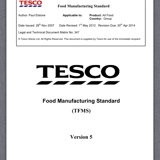Information
-
Document No.
-
Audit Title
-
Client / Site
-
Conducted on
-
Prepared by
-
Location
-
Personnel
19.1 - PROCEDURE (BASE)
-
Sites must have a clear documented policy and procedure for the management of weight, volume and count for each product manufactured, which conforms to legal requirements in the country of manufacture and intended country of sale.
-
Controls In place must meet the requirements as detailed in the Tesco product specification.
19.2 - TESCO COP (BASE)
-
All sites must comply with the requirements in Tesco COP 378 - contents control.
19.3 - WEIGHT CONTROL (BASE)
-
Allowance may need to be made for weight loss during transport and display. In the case of desiccating products, if no allowance for desiccation is made, the extent of desiccation in those products, over their entire shelf life, must be documented.
-
These documented levels must be accurate and based on thorough testing.
19.4 - WEIGHT / VOLUME CONTROL (BASE)
-
Where statistical methods are used to manage weight or volume, appropriate procedures, equipment and training must be in place.
-
Records must show the individual finished pack results for each batch.
-
Procedures must detail the actions to be taken if the results fail to meet specification.
-
WGLL - weight, volume and tare verification checks are completed hourly (or more frequently with smaller batch sizes).
-
For products that comply to EU average weight / volume legislation (agreed as part of the Tesco product specification):
-
Records must show the individual average and upper / lower results for each check
-
Procedures must detail the actions to be taken if the mean average or upper / lower results for the batch results fail to meet specification
-
Line speeds (and batch sizes) must be taken into account when determining frequency of weight and volume checks.
-
Results must be signed off by a competent individual at end of each batch
-
For products manufactured outside of the EU and not destined for sale in the EU, the procedures fro weight, volume and count must conform to legal requirements in the country of manufacture and the intended country of sale.
19.4.1 - AUTOMATED WEIGHT CONTROL (ASPIRATIONAL)
-
Products packed to either minimum or average pack weight (where applicable) utilise automated check weight systems.
19.4.2 - AUTOMATED WEIGHT CONTROL (BASE)
-
Where 'in-line' check-weigh systems are used they must be capable of recording minimum or average weight data (where legislation is applicable) and providing a printed record of weights [mean average, standard deviation and control limits where the legislation is applicable (eg. T1 & T2)] for samples and whole batches.
-
Systems controlling average weight must dynamically measure batch compliance
-
Where 'in-line' check-weigh systems are used and an automated reject system is in place, rejected products must be rejected into a locked bin or other secure method.
-
A system must be in place to verify the pack rejection mechanism is effective
-
Where automatic reject systems are not in place methods of identifying and segregating non conforming products must be in place eg. Top labels are not applied and dedicated personnel remove these packs from the line.
-
Records must be signed off at the end of each batch.
19.4.3 - AUTOMATED WEIGHT CONTROL (ASPIRATIONAL)
-
There is also a 'bin full' sensor, which stops the line after a pre-set number of items enters the bin or is rejected
19.5 - WEIGHT CONTROL (BASE)
-
All scales and equipment used for finished product weight control must have documented checks at a minimum twice per production day as part of the verification process
19.6 - VOLUME CONTROL (BASE)
-
Volume measurements must be established via the physical measurement of contents (via a calibrated container) and not established via measurements taken from the packaging eg. fill level of a bottle, unless measuring container bottles are in use
19.7 - VERIFICATION OF WEIGHT CONTROL (BASE)
-
Where required, weight checking equipment must be approved by the relevant Government Inspection or Enforcement officer.
-
The weights used to verify this must be calibrated or checked against calibrated weights on a predetermined frequency
19.8 - COUNT CONTROL (BASE)
-
Procedures must be in place to ensure that the correct number of items are present in the pack when a number has been declared
-
Documented checks of product count must be in place
19.8.1 - COUNT CONTROL (ASPIRATIONAL)
-
An automated system is in place to ensure that the count is correct
19.9 - DRAINED WEIGHT / GLAZE LEVEL (BASE)
-
All products stating drained weight or glaze levels must be verified at predetermined frequencies to confirm accuracy
19.10 - EQUIPMENT SETTINGS / SECURITY (BASE)
-
All automated content control equipment must have adequate security devices, so only authorised personnel have access to alter settings
19.11 - TRAINING (BASE)
-
All personnel involved in the management of product weight, volume and count must be trained in the correct use of the documented procedures














